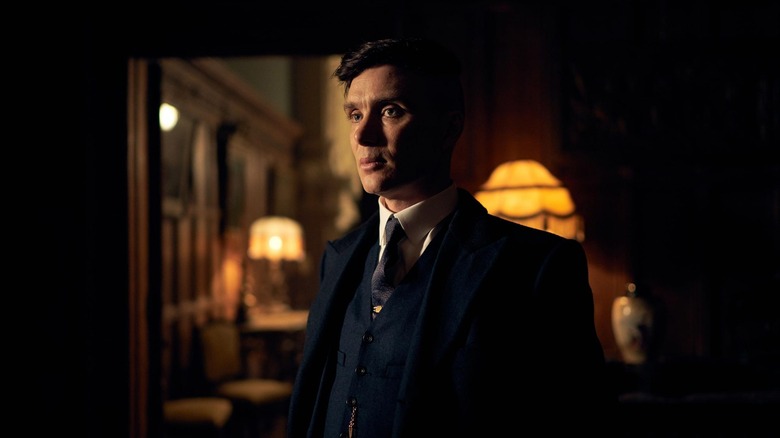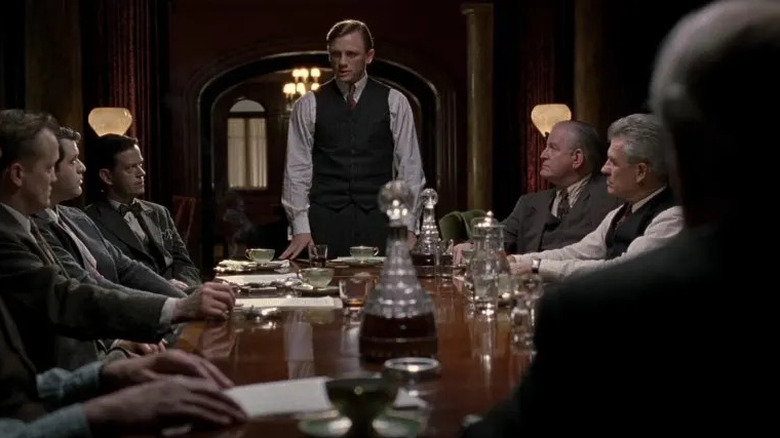How Sam Mendes' Road To Perdition Influenced Peaky Blinders Season 5
The fifth season of the post-WWI BBC/Netflix series "Peaky Blinders" sees crime boss Tommy Shelby in a Sisyphean struggle to maintain his hold on the power he's gained. Rising from Birmingham gang leader to a member of the House of Commons, Tommy (Cillian Murphy) wrestles with a formidable Scottish gang, a rising fascist with dirt on Shelby, and the fallout of the stock market crash of 1929.
Some of the aesthetics on the stylized series, like the Art Deco-esque geometric stained glass adorning the Shelby stronghold the Garrison Tavern, reflect the show's era. Others are symbolic, like the deep red tones infused throughout the tavern representing both its comforting warmth to the family and the blood on their hands. For series production designer Nicole Northridge, one major influence for season 5 came from an American crime drama about an entirely other kind of tormented gangster.
Speaking with Den of Geek in 2019, Northridge revealed that the echoes of Sam Mendes's 2002 film "Road to Perdition" reverberate off the walls of the Garrison Tavern, the industrial city of Birmingham, and even to the far reaches of Scotland as the Peaky Blinders pursue the Glaswegian Billy Boys to avenge the brutal death of one of their own. Northridge's website contains detailed photos of her work with the art and production design departments during seasons 5 and 6, for comparison. Northridge elaborated:
"A lot of the references we had were from 'Road To Perdition.' What we loved about that film was the focused light on specific areas, and the richness of color and detail in the dressing, alongside the simplicity of the composition of the shots and how cinematic they were. There's a dedicated website just to screenshots of it, and you might be able to see the [series five] similarity."
Conrad Hall gets an assist
In his streaming recommendation, /Film's Eric Vespe characterizes "Road to Perdition" as "an elegant movie that isn't afraid to get dark." By the time he would tell the story of a Great Depression-era hitman protecting his son from the mob, director Sam Mendes was already an Oscar-winning filmmaker thanks to "American Beauty," another (way more ironic) exercise in splendor and darkness that focuses on a dysfunctional family.
"Perdition" is something decidedly different, observing Tom Hanks playing against type as ruthless assassin Sullivan. When Sullivan's young son witnesses one of daddy's hit jobs, it becomes a capital P Problem for the two. They go on the run, and the rest of the film's 117-minute runtime is both a father/son road trip movie and a grim vengeance tale.
The look of the movie is captured by cinematography maestro Conrad Hall on what would be his final film. Hall already had an established working relationship with Mendes through "American Beauty," but his most celebrated works as director of photography include "Cool Hand Luke" and "Butch Cassidy and the Sundance Kid" (on the latter, he would inadvertently get one of the stars in hot water). Throughout his career, Hall's images would be characterized by focused light, deep resonance in color, and character-aimed framing — all of which can be found in "Peaky Blinders." It can also be seen in sequences like the speakeasy scene in "Road to Perdition," wherein Sullivan learns that there is a target on his (and his son's) back, and the devil is in the set decoration details:
The "Perdition" effect is clear in any given episode of the Blinders' fifth season. Northridge's incorporation of rich colors into both the lavish backdrops of Parliament and the rebuilt interiors of the Garrison Tavern, along with metaphorical significance in every light and curtain available, gives the series resonance beyond the fog of the Birmingham streets.

